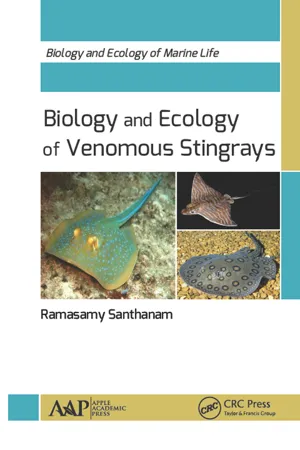
- 372 pages
- English
- ePUB (mobile friendly)
- Available on iOS & Android
Biology and Ecology of Venomous Stingrays
About This Book
This comprehensive book provides first-hand information on the diversity, biology, and ecology of venomous stingrays of freshwater, brackish, and marine ecosystems. Each year thousands of injuries to swimmers and surfers are reported, with 750 to 1, 500 stingray injuries reported each year in the US alone. As more vacationers spend their leisure time exploring coasts and tropical reefs, often in isolated areas without immediate access to advanced health care, there will be greater potential for stingray injuries. A thorough understanding about the diversity of stingrays of marine and freshwater ecosystems and their injuries and envenomations would largely improve the public health community's ability to better manage and to prevent stingray injuries. This volume fills that gap.
With over 200 photos and illustrations, this book shows the characteristics of venomous stingray families along with other profile information, such as common name, geographical distribution, diagnostic features, reproduction, predators, parasites, the International Union for Conservation of Nature's conservation status. Importantly, it includes valuable information on stingray injuries, envenomation, and medical management.
This volume will be very informative for students of fisheries science, marine biology, aquatic biology, and environmental sciences, and will become a standard reference for marine professionals, health practitioners, and college and university libraries, and as a helpful on-board
Frequently asked questions
Information
Family/genera | No. of species | Distribution | |
Dasyatidae (whiptail stingrays) | |||
Dasyatis | 43a | Atlantic, Indian, and Pacific Oceans | |
Himantura | 28b | ||
Makararaja | 1c | ||
Neotrygon | 5 | ||
Pteroplatytrygon | 1 | ||
Pastinachus | 5 | ||
Taeniura | 3 | ||
Taeniurops | 1 | ||
Urogymnus | 1 | ||
Potamotrygonidae (freshwater stingrays) | |||
Heliotrygon | 2c | Atlantic and Caribbean watersheds of South America and rivers in West Africa | |
Paratrygon | 1c | ||
Plesiotrygon | 2c | ||
Potamotrygon | 24c | ||
Gymnuridae (butterfly rays) | |||
Gymnura | 14 | Worldwide in tropical and warm temperate (subtropical) seas; Atlantic (Black Sea), Pacific, and Indian oceans | |
Myliobatidae (eagle rays/manta rays) | |||
Aetobatus | 3 | Tropical and western temperate seas | |
Aetomylaeus | 4 | worldwide; Atlantic, Pacific, and Indian oceans | |
Myliobatis | 12 | ||
Manta | 2 | ||
Mobula | 9 | ||
Pteromylaeus | 2 | ||
Rhinopteridae (cownose rays) | |||
Rhinoptera | 8 | Circumglobal distribution (temperate and tropical continental seas) | |
Urolophidae (stingarees or round stingrays) | |||
Trygonoptera | 6 | Eastern Indian, western Pacific, eastern Pacific (from California to Chile), and western Atlantic ocean | |
Urolophus | 22 | ||
Urobatis | 6 | ||
Urotrygon | 13 | ||
Hexatrygonidae (sixgill stingrays) | |||
Hexatrygon | 1 | Off South Africa | |
Plesiobatidae (deepwater stingray) | |||
Plesiobatis | 1 | South Africa; Mozambique, Australia and Western Indian ocean; west-central Pacific ocean (from Japan to Philippines) and Hawaiian Islands | |
Table of contents
- Cover
- Half Title
- Title Page
- Copyright Page
- Table of Contents
- List of Abbreviations
- Preface
- 1. Introduction
- 2. Biology and Ecology of Marine Stingrays
- 3. Profile of Marine Stingrays
- 4. Biology and Ecology of Freshwater Stingrays
- 5. Profile of Freshwater Stingrays
- 6. Stingray Injuries, Envenomation, and Medical Management
- References
- Index